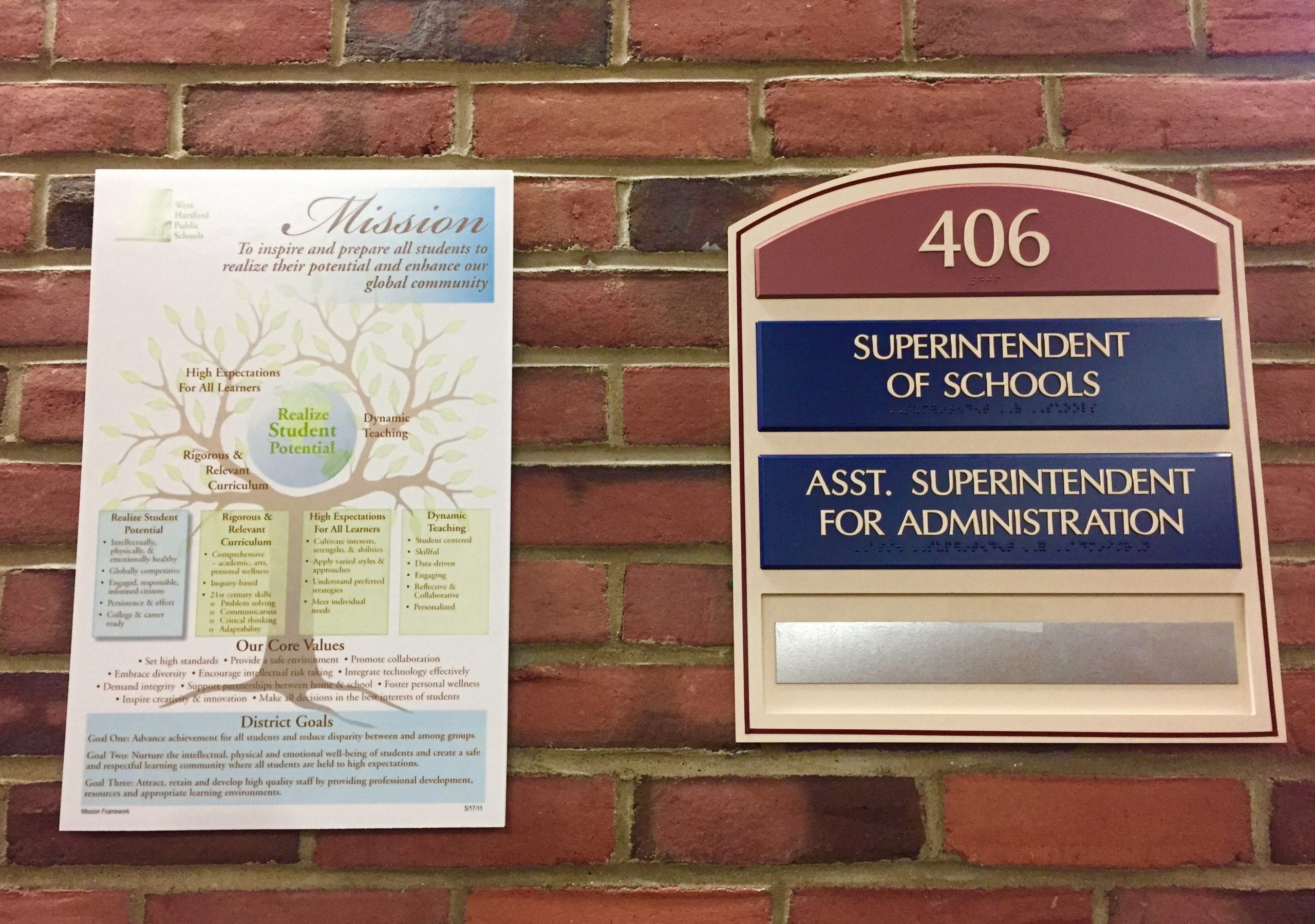Board of Education Opts to Include Air Conditioning but Not Turf Fields in Capital Improvement Plan

Audio By Carbonatix

West Hartford Public Schools Superintendent's Office. Photo credit: Ronni Newton (we-ha.com file photo)
The West Hartford Board of Education adopted its Capital Improvement Plan Tuesday night.
By Ronni Newton
The West Hartford Board of Education approved the superintendent’s proposed Capital Improvement Plan (CIP) Tuesday night by a 5-2 vote along party lines, and after extensive discussion removed a line item for additional lighted synthetic fields at Conard and Hall high schools, but retained elementary school air quality enhancements in the “out years” of the 12-year plan.
The vote to remove the synthetic fields from the CIP was also 5-2, and also along party lines.
The Board of Education passed along a CIP to the Town Manager that includes $7,740,000 for 2020-2021 and $6,834,000 for 2021-2022.
When the CIP was presented to the Board on Jan. 23, it included several program “enhancements” outside of the recurring projects that are included each year – including 2,350,000 for security improvements in 2020-2021, and $1,350,000 in 2021-2022, which will complete the project.
Although a 12-year plan is presented, the Board only approves the upcoming two-year plan. In the “out years” beginning in 2022-2023 – which is really just for planning purposes – the CIP also included air quality improvements at elementary schools, a project that will take 20 years to complete. The estimated project cost is $2,500,000 in the first year and $2,575,000 in the following year, and will increase by about $75,000-$100,000 per year in future years.
Following a suggestion by Republican Mark Zydanowicz during the CIP presentation on Jan. 23, and after discussion by Board members, an additional enhancement – the addition of lighted synthetic fields at the high schools – was added to the “out years” of the CIP for consideration. The estimated cost would be $4,000,000, spread out over 2022-2023 and 2023-2024.
The CIP has remained fairly flat for the past decade, and other than funding for security upgrades, there have been few requests for enhancements.
Assistant Superintendent Andy Morrow and Director of Plant and Facilities Bob Palmer clarified that the air quality improvement project at the elementary schools was prompted by a need for window replacement and airflow enhancement, but also includes air conditioning. The intent is to begin at Duffy Elementary School, where the need to replace the windows is “most critical.”
The work would need to be done over the summer when school is not in session, and Palmer said each building would take two summers to complete, with the entire project taking 20 years.
Board member Amanda Aronson asked how hot days are currently handled and what will be done in the meantime. Morrow noted that there are “cooling plans” that principals put into place on hot days – typically when the temperature exceeds 85 degrees – at the schools that are not air conditioned. Those plans include rotating the students through spaces that are air conditioned, such as media centers, and use of shades.
“It’s not ideal but it’s the best we have,” Morrow said.
Superintendent Tom Moore said luckily there haven’t been extended periods of high heat when schools are in session over the past few years. Last year there were eight days, he said. In years where there are more snow days and school gets out later, there tend to be more hot days to contend with at the end of the academic year.
Both high schools and all three middle schools have air conditioning, but of the elementary schools, only Charter Oak International Academy and Smith STEM are fully air conditioned.
Although it’s being recommended, the Board could decide to eliminate the air conditioning piece from the CIP, but the window replacement need is critical. “It’s absolutely your call,” Morrow told the Board. “We have to replace the windows in these buildings.”
Democrat Sean Passan said while the number of days when it’s over 85 degrees may be few, there are many more days when it’s uncomfortably warm in the buildings, and that negatively affects the educational experience. “We want to be a great school district all year long,” he said.
Republican Rob Levine said that the CIP has been in the “mid-$4 million” range for many years, but with the air conditioning project, and the proposed field project, it would rise to $10 million or more. He said there are many important conversations that have to take place in the next few months.
“There are lots of nice-to-haves,” he said, but asked if there are other areas where corners can be cut. “At some point we have to make hard choices.” He suggested a “delay,” perhaps in turnover of computer equipment, but Moore said the five-year turnover for that equipment is “already stretching it.”
Morrow said that some projects are already being deferred more than they should be.
The Board of Education’s CIP is rolled into the overall Capital Improvement Plan for the town, and the majority is financed through bonds issued on an annual basis and repaid over a 20-year period, Director of Finance and Planning Elizabeth Hewitt said. It is separate from the operating budget for the Board of Education and the town.
Board Chair Deb Polun asked if there was the possibility of obtaining any grant funding, and Palmer said it’s possible that there would be state funding for the window replacement and ventilation, but not for the air conditioning.
Zydanowicz reiterated his support Tuesday for including the line item for an additional synthetic field, with lights, at both high schools, and said that athletics “is part of education.”
Funding was not scheduled to begin until the 2022-2023 school year, so it would only be included for planning purposes at this time. Zydanowicz requested leaving the fields in the CIP because it “starts the conversation for the town manager and those who are making that decision.”
In addition, he said, the sports leagues would be doing fundraising for fields – but no one would be fundraising for air conditioning.
Passan said it’s the Board’s responsibility to “make decisions on what’s best for the classrooms,” and air conditioning has a direct effect on instruction. He said while he is a soccer coach and loves the idea of more fields, he preferred getting more information from the athletic director regarding the status of the existing facilities before putting the fields in the budget.
“I love synthetic fields, I’m just not ready to vote for them,” Passan said. He said he would like to have more discussion.
Moore – and Morrow – both noted that the fields and other athletic facilities are not just for use by the schools, and it’s also a town asset. Both also reminded the Board members that they would not actually be voting for funds to be included for fields at this time – or for air conditioning – because neither project was planned for the next two years.
“You shut it down now, there’s no discussion,” Zydanowicz said.
Polun, however, said the Board can still can discuss adding athletic fields and keep the concept alive, even if it’s not a line item in the CIP.
Four residents, representing numerous youth sports leagues in town, spoke to the Board of Education at the beginning of the meeting, all urging support of an additional lighted turf field at Conard and Hall high schools.
Paul McConnell said he felt like if the Board doesn’t include the fields now, “it won’t ever.”
Tracy Bourgoin, representing West Hartford Youth Football, said that West Hartford players are at a disadvantage compared to other towns, where they have practice fields and lights. Not being able to practice enough, is “definitely a safety issue,” she said.
Ed Espinal and John Monnes both noted that participants in West Hartford’s youth soccer leagues are also at a disadvantage compared to those in other towns because fields are often closed when it rains.
“The windows to get on the field [at Conard or Hall] are very slim,” Espinal said.
Monnes said during rainy years sometimes games aren’t able to be made up. “Having another turf field would give the kids the opportunity to play more.”
Following the meeting, Zydanowicz expressed his disappointment with the vote to remove the fields from the CIP, and was upset that it appeared to have been turned into a partisan issue.
“I’m very disappointed that politics and ideology got in the way of a non-partisan issue,” he said. “The Democrats went from supporting it last meeting, to removing it all together with no future discussion. They turned the multi-use fields, benefiting our youth and high school athletes, into a political grandstand. The Democrats left no opportunity for further discussion, which was the entire reason it was in the CIP. We were not voting on funds, just an idea, to help move the conversation and to generate input from the community and our athletes. They took that opportunity away from them.”
McConnell also shared his disappointment after learning that fields had been removed as a line item from the CIP, and called it a “Democratic party power move.”
Morrow said he is pleased that the Board and the Town have been so supportive of the requested security improvements. “[The] commitment to security is fantastic,” he said.
The Board of Education’s CIP gets rolled into the overall town’s capital improvement plan, Morrow said, and the Town Council can still make changes to the overall amount – but can’t delete items on a line-item basis.
Town Manager Matt Hart said Thursday that he has not yet been approached to have additional athletic fields included in the town’s budget.
Moore will present the West Hartford Public Schools general fund budget for 2020-2021 to the Board on March 3. That meeting begins at 7 p.m. Several Board workshops and a public hearing will follow.
The Town Council will adopt the overall budget, which will include the school budget, on April 20.
Like what you see here? Click here to subscribe to We-Ha’s newsletter so you’ll always be in the know about what’s happening in West Hartford!




I have to disagree with Mark Zydanowicz statement: “The Democrats went from supporting it last meeting, to removing it all together with no future discussion. They turned the multi-use fields, benefiting our youth and high school athletes, into a political grandstand.”
It looks more like the projection so favored by the occupant of their highest office. Typically, Republicans lob criticism across the aisle meant to highlight the spending proclivities of Democrats. Once the Democrats make a decision that reflects a conservative use of funds our Republican minority objects and supports spending the money. Welcome to bizarro world.
While I find that the appetite for spending money in this town is excessive, I don’t think that missing soccer games is a $4million problem.
I would love to have good candidates from both parties but the comments and votes coming from the Republican members here are nothing more than opposition, not governing.
[…] returned Tuesday afternoon (in plenty of time to attend and report on the Board of Education meeting), but Ted had left to go on a ski trip out west with a friend earlier that day. Millie was […]